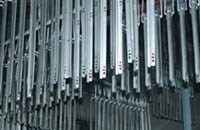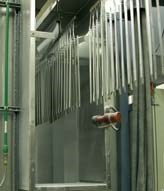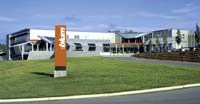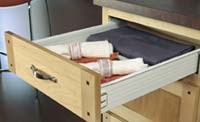At Blum USA, Quality Finishing "Hinges" on Pretreatment
In response to quality issues, Blum USA worked with industry supplier GE Infrastructure,Water & Process Technologies to develop a new pretreatment system. The result? Improved salt spray results, not to mention an annual savings of more than $180,000…
Ask a powder coater to tell you the three keys for obtaining a quality coating, and he's likely to say, "pretreatment, pretreatment and pretreatment." It is difficult to overestimate the impact—positive or negative—that pretreatment can have on your final finish. That philosophy is nowhere more true than at Blum USA, a manufacturer of high quality hardware systems for drawers and cabinets.
Blum USA was established in Stanley, North Carolina—located about 20 miles northwest of Charlotte—in 1977. Its parent company, Austrian-based Julius Blum GmbH was founded in 1952 as a manufacturer of replaceable studs for horseshoes. Six years after its inception, the company began producing hinges for doors, windows and furniture.
Today, Blum employs more than 4,100 people around the world, with production facilities in Austria, the United States and Brazil. Nearly 400 of those employees work at Blum USA's 400,000-sq-ft facility in Stanley, which recently announced plans for a $30 million expansion.
Though Blum USA produces hinges and organizational systems, drawer runners constitute the core of the company's business (all of the products manufactured in Stanley are targeted at the North American market).
Because Blum's products come with a lifetime guarantee, the drawer runners manufactured in Stanley are powder coated not only for aesthetics but also for durability. That work takes place in the paint shop, which occupies nearly a quarter of the production facility's floor space and features dual pretreatment and powder coating lines. Blum USA uses automatic spray guns supplied by ITW Gema and relies exclusively on powder coatings from the HB Fuller Company.
Problems With Pretreatment
Three years ago, Blum contacted GE's Water & Process Technologies in response to quality issues that the company was experiencing with its pretreatment system. Not only was there difficulty in reaching neutral salt spray requirements, but increased line stoppages, operator workload and scrap rates were occurring as a result of difficulty in controlling and maintaining bath concentrations. "Chemicals were being added by dumping buckets and we really had no written guidelines for making chemical additions," says Monty Johnson, production engineer for Blum.
GE responded by executing a series of surveys involving the production process at Blum. It also performed metallurgical and soil analyses, and laboratory testing of a number of alternative pretreatment programs that would meet or exceed Blum's quality and logistical requirements.
Ultimately, two programs were identified by GE and tested at Blum. The first was a traditional five-stage iron phosphate process, which led to greatly improved salt spray results in on-line testing. A second program—a non-phosphate process—was identified as another means of meeting Blum's salt spray requirements, with the potential for cost savings.
After rigorous, Six-Sigma driven testing, GE and Blum elected to move forward with the non-phosphate system, a five-stage program consisting of an alkaline cleaner operated at 130–140°F, followed by three rinse stages and a non-chrome sealer (operated at ambient temperature) to improve the corrosion resistance and paint adhesion.
GE also equipped Blum with its proprietary automation technology. As part of the program, Walchem controllers were installed on both of Blum's pretreatment lines. These were put in place to optimize chemical feeds, enhance health and safety by minimizing manual additions and provide assurance that proper control was being maintained. The automation also meant that fewer man- hours would be required to maintain the pretreatment line.
Saving Costs, Reducing Waste
To date, Blum has realized an annual cost savings of approximately $181,000. Johnson attributes the savings to the decreased chemical use and waste treatment—a result of the elimination of the phosphate stage and the introduction of the automation technology.
One of the significant sources of cost savings is the fact that, whereas the old pretreatment system relied on two heated stages, the new one uses only one (the alkaline cleaner). The other four stages, including the sealer, are all operated at ambient temperature. That difference alone has accounted for a $100,000 decrease in Blum's yearly energy costs.
With the elimination of phosphates from the waste stream, treatment is now much less costly and overflow to waste treatment has been nearly cut in half—a fact that has management at both GE and Blum very pleased. Consequently, GE recently presented Blum with its Return on Environment (ROE) award in recognition of Blum's environmental strategy. The award was developed in 1992 as a means of recognizing a select group of customers who demonstrate that environmental responsibility and profitability are compatible. It marks the second time that Blum has received the award.
For its part, Blum has been ecstatic about the new pretreatment system. "With the installation of the chemical pumps and controllers, together with the new chemistry, the pretreatment of our parts has never been better," says Johnson.
Related Content
Low-Temperature-Cure Powder Coatings Offer Unique Opportunities
An in-depth look at the advantages of low-temperature-cure powder coatings and the considerations for incorporating them into your process.
Read MoreCuring Oven Basics
Simply heating up the substrate does not cure the coating. There are many variables to consider when choosing the best cure oven for your application...
Read MoreMasking Solutions Provider CFS Dramatically Expands Capabilities and Capacity
Custom Fabrication & Supplies (CFS) completed a new plant expansion packing 10 times the capacity into twice the space. It dramatically enhances the supplier’s custom capabilities to provide extremely precise and cost-effective masking solutions.
Read MorePowder Coating 4.0: Smarter, Faster, More Efficient and Connected
New tools reduce cost and waste, lower manufacturing footprint of powder coating operations.
Read MoreRead Next
Delivering Increased Benefits to Greenhouse Films
Baystar's Borstar technology is helping customers deliver better, more reliable production methods to greenhouse agriculture.
Read MoreEducation Bringing Cleaning to Machining
Debuting new speakers and cleaning technology content during this half-day workshop co-located with IMTS 2024.
Read MoreA ‘Clean’ Agenda Offers Unique Presentations in Chicago
The 2024 Parts Cleaning Conference, co-located with the International Manufacturing Technology Show, includes presentations by several speakers who are new to the conference and topics that have not been covered in past editions of this event.
Read More


























